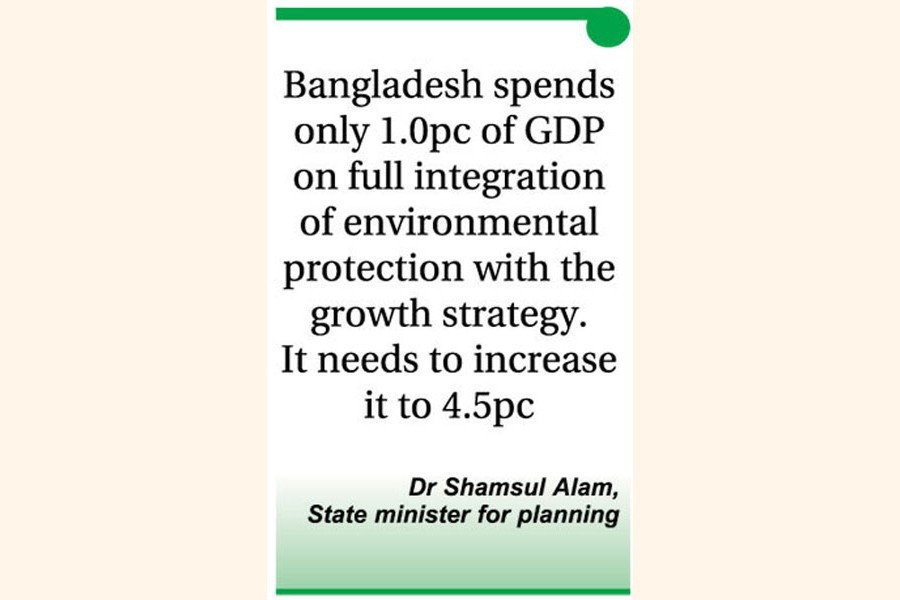Speakers at a discussion underscore the need for continuing economic growth pattern alongside engaging higher efforts to be green, keeping in mind the impacts of climate change.
They also discuss allocation of more resources to adapt and mitigate the adverse climate-change impacts.
The speakers said this at a Policy Research Institute of Bangladesh (PRI)-hosted consultation styled 'Climate Change and Institutions in Bangladesh' presided over by PRI chairman Dr Zaidi Sattar on Wednesday.
State minister for planning Dr Shamsul Alam says Bangladesh spends only 1.0 per cent of the gross domestic products (GDP) on full integration of environmental protection with the growth strategy.
It needs to increase the funding to an estimated 4.5 per cent of GDP to ensure a sound environment and face climate-change impacts properly, he adds.
"We have to go a long way to turn our economy green with green growth," says Dr Alam.
Sustainable growth can only be ensured when the country has a green economy with healthy living standards.
"We should go with our climate issues mainstreaming in our budget formulation process," Dr Alam cites.
World Bank practice manager on climate change and disaster risk management Abhas Jha says Bangladesh is seventh-most climate change-affected country and its estimated annual loss is $3.0 billion from the hazard.
The coastal zones of the country are subjected to multiple threats and the World Bank has recently started a new diagnostic to assess the impacts.
"We cannot isolate climate change from development. Climate change has to be mainstreamed in every aspect of development and growth path," Mr Jha says.
In his speech, Dr Sattar said Bangladesh should continue with its high-growth experience that it was doing without having to sacrifice its growth.
"It can still continue growth and be green."
Citing South Korea as an example, Dr Sattar said one should see how a poor country turned it rich in 50 years and also remained green.
Bangladesh contributes only 0.25 per cent to global greenhouse gas emissions but it still needs to exercise restraint and curb emissions and adapt to climate change, he observes.
An additional investment of $3.5 trillion a year would be required to achieve net-zero transition globally, said Dr Sattar.
But 200-million jobs would be created with new technological adoption while 185-million jobs be lost, he added.
The PRI chief says Bangladesh has made specific commitments to contain its own GHG emissions albeit as an LDC, it is not required to make any such commitments.
"That's why, an assessment of Bangladesh's institutional readiness for coping with and addressing climate change becomes relevant," he cites.
PRI executive director Dr Ahsan H Mansur says, "Bangladesh is particularly vulnerable country and our vulnerability particularly comes from multiple sources."
Census data shows the population in southern districts as a whole is declining and they become climate refugees, he adds.
"And we all know that climate change is going to cause a much bigger refugee problem in Bangladesh. So, we have to prepare us to face the problem properly."
There are serious institutional weaknesses who will be involved in climate-change adaptation and mitigation issues. So, institutional challenges remain a major problem, according to Mr Mansur.
"Our resource constraints are very serious and we know that it's not going to be away unless we seriously enhance domestic resource mobilisation," he utters.
PRI senior fellow Dr Hasan Moinuddin presented a keynote styled 'Climate Change Institutional Assessment' where Department of Environment director Mirza Shawkat Ali, World Bank practice manager Hoon Sahib Soh, Bangladesh Chamber of Industries president Anwar-ul-Alam Chowdhury (Parvez) and RDRS Bangladesh senior agriculture coordinator Mamunur Rashid also spoke.


